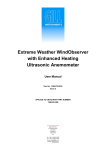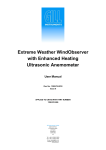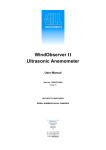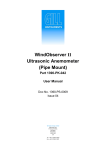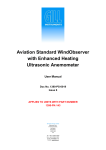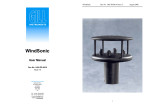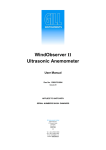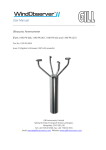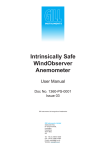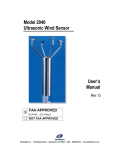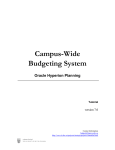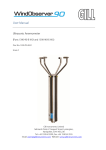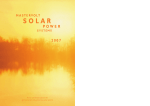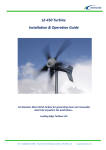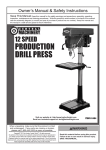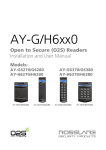Download Gill Aviation Standard WindObserver Anemometer User Manual
Transcript
Aviation Standard WindObserver with Enhanced Heating Ultrasonic Anemometer User Manual Doc No. 1390-PS-0019 Issue 1 APPLIES TO UNITS WITH PART NUMBER 1390-PK-079 Gill Instruments Limited Saltmarsh Park, 67 Gosport Street, Lymington, Hampshire. SO41 9EG UK Tel: +44 (0) 1590 613500 Fax: +44 (0) 1590 613501 E-mail: [email protected] Website: www.gill.co.uk Gill Instruments Ltd _____________________________________________________________________________________________________________ Aviation Standard WindObserver Anemometer ________________________________________________________________________________________________ Aviation Standard WindObserver Page 2 Issue 1 Doc. No. 1390-PS-0019 April 2009 Gill Instruments Ltd _____________________________________________________________________________________________________________ Contents 1. 2. 3. 4. 5. FORWARD ..............................................................................................5 INTRODUCTION......................................................................................5 FAST TRACK SET-UP ............................................................................5 SPECIFICATION .....................................................................................6 PRE-INSTALLATION ..............................................................................7 5.1. 5.2. Equipment supplied .......................................................................................... 7 Installation requirements................................................................................... 7 6. INSTALLATION.......................................................................................8 6.1. 6.2. 6.3. 6.4. Installation Guidelines....................................................................................... 8 Bench system test ............................................................................................ 9 Cabling ............................................................................................................. 9 Connections.................................................................................................... 10 Default Settings....................................................................................................... 11 Connecting to a PC with a RS422 or RS485 input ................................................. 11 Networking units ..................................................................................................... 12 6.5. Indoor Power and Communications Interface (Part 1189-PK-021) .................. 13 Connecting to a PCI Unit with RS422 input ............................................................ 13 PCI Electrical Power Requirements........................................................................ 13 PCI Connector Pin and Cable assignments ........................................................... 14 Anemometer connector – 15 way ........................................................................... 14 Auxiliary Analogue Outputs – 9 way ....................................................................... 14 DC Supply – 4 way ................................................................................................. 14 RS 232 Output – 9 way........................................................................................... 15 RS422 Network In – 9 way Skt ............................................................................... 15 RS422 Network Out – 9 way Plg ............................................................................ 15 6.6. 6.7. Power supplies ............................................................................................... 16 Mechanical installation.................................................................................... 17 Location................................................................................................................... 17 Orientation .............................................................................................................. 17 Mounting bracket .................................................................................................... 17 Alignment ................................................................................................................ 19 Figure 2a North marker and UV polarity definition (UV format) and Mounting Ring19 Figure 2b Aviation Standard WindObserver outline dimensions ............................ 20 7. USING WITH THE GILL WINDDISPLAY ..............................................21 Connecting to a Gill WindDisplay ........................................................................... 22 8. MESSAGE FORMATS & OPTIONS......................................................23 8.1. 8.2. Wind Speed format ......................................................................................... 23 Output formats ................................................................................................ 23 8.3. 8.4. 8.5. Networking...................................................................................................... 24 Units ............................................................................................................... 25 Output rate...................................................................................................... 25 8.6. 8.7. Averaging (Digital Data).................................................................................. 25 Heating ........................................................................................................... 25 8.8. 8.9. 8.10. 45° Offset........................................................................................................ 25 Vertical Output Padding .................................................................................. 25 ASCII message format (UV and Polar) ........................................................... 26 Low wind speeds .................................................................................................... 23 Sample Average ..................................................................................................... 25 ASCII UV format .................................................................................................... 26 ________________________________________________________________________________________________ Aviation Standard WindObserver Page 3 Issue 1 Doc. No. 1390-PS-0019 April 2009 Gill Instruments Ltd _____________________________________________________________________________________________________________ ASCII Polar format .................................................................................................. 27 8.11. NMEA Format ................................................................................................. 28 9. CONFIGURING......................................................................................29 9.1. 9.2. 9.3. 9.4. 9.5. Entering Configuration mode .......................................................................... 29 Returning to Measurement mode.................................................................... 29 Checking the configuration ............................................................................. 30 Changing settings ........................................................................................... 30 Configuration Settings..................................................................................... 30 Ax – Not Applicable................................................................................................. 30 BX - Baud Rate ....................................................................................................... 31 Cx- Not applicable................................................................................................... 31 Dx- Diagnostic and Configuration Command (see also Section 10.6) ................... 31 Ex - Full Duplex/Half Duplex Mode........................................................................ 32 Fx- Data and Parity Options ................................................................................... 32 Gx to Gxxxx - Averaging (Digital Outputs only) ...................................................... 32 Hx - Heating ............................................................................................................ 32 Jx - Not applicable .................................................................................................. 32 Kx – NMEA Settings ............................................................................................... 32 Lx - ASCII Message Terminator ............................................................................. 32 Mx to Mxx - Message Format ................................................................................. 33 Nx - Node Address.................................................................................................. 33 Ox – ASCII Output Format (Output String Padding)............................................... 33 Px - Output Rate ..................................................................................................... 33 Q- Measurement Mode ........................................................................................... 33 Tx - Not Applicable.................................................................................................. 34 Ux – Digital Output Units......................................................................................... 34 Vx- Vertical Output Padding.................................................................................... 34 Xx - 45° Alignment Offset/Inverted Operation ........................................................ 34 Yx – Not Applicable................................................................................................. 34 Zx – Not Applicable................................................................................................. 34 10. MAINTENANCE & FAULT-FINDING ....................................................35 10.1. 10.2. 10.3. 10.4. 10.5. 10.6. Cleaning and Handling.................................................................................... 35 Servicing......................................................................................................... 35 Fault-finding.................................................................................................... 35 Returning units................................................................................................ 36 Status (error) codes ........................................................................................ 36 Bench test....................................................................................................... 37 Integrity & Zero Wind Check ................................................................................... 37 11. APPENDICES........................................................................................39 11.1. 11.2. 11.3. 11.4. Glossary & Abbreviations................................................................................ 39 Guarantee....................................................................................................... 40 Principle of operation ...................................................................................... 41 Electrical Conformity....................................................................................... 42 ________________________________________________________________________________________________ Aviation Standard WindObserver Page 4 Issue 1 Doc. No. 1390-PS-0019 April 2009 Gill Instruments Ltd _____________________________________________________________________________________________________________ 1. FORWARD Thank you for purchasing the Aviation Standard WindObserver with Enhanced Heating manufactured by Gill Instruments Ltd. The unit has no customer serviceable parts and requires no calibration or maintenance. To achieve optimum performance we recommend that you read the whole of this manual before proceeding with use. Do NOT remove black “rubber” transducer caps. Gill products are in continuous development and therefore specifications may be subject to change and design improvements without prior notice. The information contained in this manual remains the property of Gill Instruments and should not be copied or reproduced for commercial gain. 2. INTRODUCTION The Gill Aviation Standard WindObserver has been accepted for service by both the Federal Aviation Administration (USA) and the Civil Aviation Authority (UK) for the observation and reporting of surface wind. The Aviation Standard WindObserver meets the requirements of Annex 3 to the Convention on International Civil Aviation Organisation (ICAO) when supplied as part of an Automatic Weather Observing System (AWOS). The Aviation Standard WindObserver wind sensor is a very robust, lightweight unit with no moving parts, outputting wind speed and direction. The units of wind speed, output rate and formats are all user selectable. The Aviation Standard WindObserver is available with enhanced de-icing heating (recommended if severe icing is likely). The Aviation Standard WindObserver can be used in conjunction with a PC, data logger or other device, provided it is compatible with the RS422 output. Multiple units can be networked if required. Alternatively, the Aviation Standard WindObserver is designed to connect directly to the Gill WindDisplay unit to provide a complete wind speed direction system without any configuration required by the user. The output message format can be configured in Polar, UV (2-axis), NMEA (0183 Version 3), Tunnel formats, and as either a Continuous output or Polled (requested by host system), detailed in full in Section 8 Message Formats & Options. Aviation Standard WindObserver may be configured using WindCom software which is available, free of charge, from the Gill website www.gill.co.uk, or by using standard communications software on a PC. This is explained in Section 9 Configuring. 3. FAST TRACK SET-UP If you are in a hurry to try out the Aviation Standard WindObserver, are familiar with Gill equipment, and coupling to a PC using RS422, go to the following sections: Section 6 Installation Section 8 Message Formats & Options Section 9 Configuring After you have successfully set up the Aviation Standard WindObserver, we strongly advise that you then go back and read the rest of the manual to ensure that you get the best results from the Aviation Standard WindObserver. ________________________________________________________________________________________________ Aviation Standard WindObserver Page 5 Issue 1 Doc. No. 1390-PS-0019 April 2009 Gill Instruments Ltd _____________________________________________________________________________________________________________ 4. SPECIFICATION Measurement Output Parameters Units Averaging Wind Speed Range Accuracy Resolution Offset Direction Range Accuracy Resolution Anemometer Status Starting Threshold Dead Band Wind Direction Power Requirement Anemometer only Heating - Optional Digital Output Communication Baud rates Formats Dimensions Size Weight Materials External Construction Environmental Moisture protection Operating temperature Humidity Precipitation EMC Icing Standards Site Calibration 1, 2, 4 Hz UV, Polar, NMEA m/s, Knots, MPH, KPH ft/min Flexible 1-3600 seconds 0 - 75m/s ±2%@12m/s 0.01m/s ±0.01m/s 0 - 359° ± 2° 1° Supplied as part of standard message 0.01 m/s None 20-30 V DC 50mA average, reverse voltage protected Allow for 7A @ 24v AC rms ± 15%, or 24v DC± 10%. RS422, full duplex, network facility 1200, 2400, 4800, 9600, 19200, 38400 8 data, odd, even or no parity 381mm x 213mm 1.4kg (no cable) Stainless Steel 316 IP66 (NEMA4X) -55°C to +70°C, heating on 0% to 100% RH 300mm/hr EN 61326-1: 2006 EN 55011:2007 MIL STD 810F Method 521.1 Procedure 1 Traceable to UK national standards None required. (See Section 10.6 Zero Wind Check) WARNING NOTE:- When heating is activated the bullet and transducer arms will get very hot and should not be handled. ________________________________________________________________________________________________ Aviation Standard WindObserver Page 6 Issue 1 Doc. No. 1390-PS-0019 April 2009 Gill Instruments Ltd _____________________________________________________________________________________________________________ 5. PRE-INSTALLATION 5.1. Equipment supplied and and and Aviation Standard WindObserver RS422 output and de-icing. Installation kit (comprising a gasket and four Stainless Steel screws). Aviation Standard WindObserver User Manual (this manual) Integrity Check Chamber (ICC) (Optional) 5.2. Installation requirements Host system - One of the following: PC with an internal or external interface compatible with the RS422 output from the Aviation Standard WindObserver. Gill WindDisplay. Other equipment with I/O compatibility to the WindObserver Aviation Standard. For example if the unit has Digital outputs, a Data Logger, Chart Recorder, or PC. Networking - Multiple Aviation Standard WindObserver units can be networked Software - One of the following: WindCom – A user-friendly package providing easy configuring of the Aviation Standard WindObserver, for use on PCs running under Windows™ 98, 2000 or XP. Available to customers as a free download from www.gill.co.uk. HyperTerminal (for Windows™ 9x and later), or Terminal (Windows™ 3.n), normally already installed on a PC. Other Terminal Emulation software packages Cable and Junction box To connect between the Aviation Standard WindObserver and the host system. The unit is supplied with a flying cable, requiring a mast mounted junction box (not provided) for onward connection. The flying cable must be retained with a cable tie within 150mm of the base of the anemometer. Mounting Bracket A mounting bracket is required (not provided) which will attach to the Aviation Standard WindObserver via the four tapped holes in the base of the unit. Always ensure that the gasket supplied is fitted to the base of the anemometer. It is important that the gasket supplied forms a watertight seal on the base of the anemometer. In the event that the mounting bracket supplied by the customer is not flat or does not form complete support for the anemometer base; the customer must fit a mounting ring as shown in Figure 2. ________________________________________________________________________________________________ Aviation Standard WindObserver Page 7 Issue 1 Doc. No. 1390-PS-0019 April 2009 Gill Instruments Ltd _____________________________________________________________________________________________________________ 6. INSTALLATION Do NOT remove the black “rubber” transducer caps. Warranty is void if the Red security seal is damaged or removed. Take care not to knock the four Transducer arms. All the time the Aviation Standard WindObserver is not in its final location, it should be protected from damage by keeping it in the original packaging as long as possible, treating it as a delicate instrument. If an Intrinsically Safe (IS) device is required, the I.S. WindObserver must be used - the Aviation Standard WindObserver is NOT an IS device. 6.1. Installation Guidelines The Aviation Standard WindObserver has been designed to meet and exceed the stringent standards listed in its specification. Operating in diverse environments all over the world, Aviation Standard WindObserver requires no calibration or adjustment whatsoever. As with any sophisticated electronics, good engineering practice should be followed to ensure correct operation. Always check the installation to ensure the Aviation Standard WindObserver is not affected by other equipment operating locally, which may not conform to current standards, e.g. radio/radar transmitters, boat engines, generators etc. Guidelines – Avoid mounting in the plane of any radar scanner – a vertical separation of at least 2m should be achieved. Radio transmitting antennas, the following minimum separations (all round) are suggested • VHF IMM – 1m • MF/HF – 5m • Satcom – 5m (avoid likely lines of sight) Ensure the product is correctly earthed in accordance with this manual Use cables recommended by Gill, keeping the length below the maximum allowed (See Section 6.3) Where the cables are cut and re-connected (junction boxes, plugs and sockets) the cable screen integrity must be maintained, to prevent the EMC performance being compromised. Earth loops should not be created – earth the system in accordance with the installation guidelines. (See Section 6.4) Ensure the power supply operates to the Aviation Standard WindObserver specification at all times. Avoid turbulence caused by surrounding structures that will affect the accuracy of the Aviation Standard WindObserver such as trees, masts and buildings. The World Meteorological Organisation makes the following recommendation: The standard exposure of wind instruments over level open terrain is 10m above the ground. Open terrain is defined as an area where the distance between the sensor and any obstruction is at least 10 times the height of the obstruction. When installing the unit degrease the unit and hold with lint free gloves to reduce the build up of deposits. ________________________________________________________________________________________________ Aviation Standard WindObserver Page 8 Issue 1 Doc. No. 1390-PS-0019 April 2009 Gill Instruments Ltd _____________________________________________________________________________________________________________ 6.2. Bench system test Note: Prior to physically mounting the Aviation Standard WindObserver in its final location, we strongly recommend that a bench system test be carried out to confirm the system is configured correctly, is fully functional and electrically compatible with the selected host system and cabling (preferably utilising the final cable length). The required data format, units, output rate, and other options should also all be configured at this stage. If an Integrity Check Chamber (ICC) has been purchased refer to Section 10.6. 6.3. Cabling Cable type A RS422 compatible cable should be used, with the number of twisted pairs matching the application. Generic description – Twisted pairs with drain wire, screened with aluminised tape, with an overall PVC sheath. Wire size 7/0.2mm (22 or 24 AWG) The table shows some suitable manufacturers’ references; other manufacture’s equivalents can be used. Table 1 Belden Batt electronics No. of pairs Gill ref. ref. ref. 2 9729 91071 3 026-02660 9730 91030 4 026-03156 9728 91199 6 8778 91011 9 026-02663 8774 91009 Cable length The typical maximum length at 9600 baud is 1km (3200ft), using the recommended cable. If any problems of data corruption are experienced (due to, for example, a high local electrical ‘noise’ level), then a lower baud rate should be used. Alternatively, a thicker or higher specification cable can be tried. Cabling and junction box The Aviation Standard WindObserver unit is fitted with a flying 9 pair cable attached. This must be terminated in a suitable terminal box to IP66 or better, fitted with glands to prevent moisture ingress. The cable type from the terminal box to the host system must be as specified above. If any cable is likely to be exposed to mechanical damage, it must be enclosed in a suitable conduit or cable tray. The cable must be securely fixed with cable clamps or equivalent, such that the cable is not under stress at the Aviation WindObserver cable gland or terminal box glands. The gland area at the base of the Aviation Standard WindObserver should not be directly exposed to moisture, as whilst the gland is sealed when mated, the anemometer is vented to air at the base to avoid pressure build up. If an IP66 rating is essential or the unit is mounted other than ‘right way up’ use the gasket provided in the mounting kit. ________________________________________________________________________________________________ Aviation Standard WindObserver Page 9 Issue 1 Doc. No. 1390-PS-0019 April 2009 Gill Instruments Ltd _____________________________________________________________________________________________________________ 6.4. Connections Important Any cores not used should be isolated. Do NOT connect the unit’s 0V, heating –ve, or digital 0V to the screen or earth. The screens of each pair are joined together inside the anemometer - these should be joined to the cable screen(s) of any further cable run. Avoid long grounding loops. Digital OV should be used in conjunction with RS422 TX RX lines in order to improve noise immunity. Each pair in the cable is labelled with its pair number. Table 2 Conductor colour Designation Pair 1 green RS422_TXB (+) black RS422_TXA (-) Pair 2 white RS422_RXB (+) black RS422_RXA (-) Pair 3 red Supply V+ black Supply VPair 4 blue Digital 0v black Not used (isolate) Pair 5 yellow Heater + black Heater – Pair 6 brown Heater + black Heater – Pair 7 orange Heater + black Heater – Pair 8 white Not used (isolate) red Not used (isolate) Pair 9 green Not used (isolate) red Not used (isolate) Screens Chassis ground Earthing or grounding To ensure correct operation, and for maximum protection against lightning, the anemometer MUST be correctly earthed (grounded) via its mountings. Inadequate Earthing will degrade anemometer performance, particularly in the presence of radio frequency interference. See Fig 1 Suggested mounting bracket and Earthing (grounding) arrangements The unit MUST be connected to an appropriate grounding point with a minimum of 6mm² copper wire, via the M5 base screws. The cable screens must be joined with any cable screen continuing from the unit’s cable via a junction box. The primary earth for the anemometer must be provided via the base screws and not via the cable screens. ________________________________________________________________________________________________ Aviation Standard WindObserver Page 10 Issue 1 Doc. No. 1390-PS-0019 April 2009 Gill Instruments Ltd _____________________________________________________________________________________________________________ Default Settings The factory default settings are: A0 B3 C1 E1 F1 G0000 H1 J1 K1 L1 M2 NA O1 P1 T1 U1 V1 X1 Y1 Z1 Note that the Heating (H Command) is not enabled as a default condition. If heating is required then the H command must be set for H2. See Section 9 Configuring for further details. Connecting to a PC with a RS422 or RS485 input The PC requires either an internal RS422 interface card, or an external RS422/485 to RS232 converter, which will plug into the standard 9 way or 25 way RS232 serial port of the PC or host equipment. High Speed WindObserver 9 pair cable Pair Signal names Colour no. TXB (+) green 1 TXA (–) black PC with RS422 or RS485 input Cable – 6 or 9 twisted pairs Signal names RXB (+) RXA (–) RXB (+) RXA (-) 2 white black TXB (+) TXA (–) Digital 0V 4 blue Signal Ground CONNECTED INTERNALLY Supply V+ Supply V- 3 Heater + 5&6 &7 Heater - red black Yellow/ Brown/ Orange Black/ Black/ Black Screen and drain wires Ground (Earth) + - + - DC Power Supply 20 – 30V See Section 6.6 Heater Power Supply See Section 6.6 Note:Heater Pair wires Yellow, Brown and Orange should be connected in Parallel, as too should the return 3 Black wires. ________________________________________________________________________________________________ Aviation Standard WindObserver Page 11 Issue 1 Doc. No. 1390-PS-0019 April 2009 Gill Instruments Ltd _____________________________________________________________________________________________________________ Networking units Before coupling units into a network: Each device must be configured with a unique Unit Identifier (letter A to Z) however in multi drop systems it could be advised to avoid using letters A-F, K,M,N and P as they could appear in the data string. Unit must be set for half duplex mode (E2 setting) see Para 8.3). It must be configured to a tri-state polled mode M3 or M4 . See also Section 9 - Configuring Aviation Standard PC with RS485 WindObserver card 9 Pair Cable Signal Names Pair Colour Signal Names no TXB (+) 1 Green T/RXB (+) RXB (+) 2 White TXA (-) RXA(-) 1 2 Black Black T/RXA (-) Digital 0v CONNECTED INTERNALLY 4 Blue Signal Ground Ground Earth Supply V+ Supply V- 3 3 Red Black + DC Power - Supply 20-30v See Section 6.6 Heater + 5 6 7 5 6 7 Yellow/ Brown/ Orange Black/ Black/ Black Heater - + Heater Power Supply * - See Section 6.6 To Next Unit Notes:Heater Pair wires Yellow, Brown and Orange should be connected in Parallel, as too should the return 3 Black wires. Each unit in the network will require its own power supplies. Please refer to section 8.3. ________________________________________________________________________________________________ Aviation Standard WindObserver Page 12 Issue 1 Doc. No. 1390-PS-0019 April 2009 Gill Instruments Ltd _____________________________________________________________________________________________________________ 6.5. Indoor Power and Communications Interface (Part 1189-PK-021) The desktop PCI is intended for use in a protected environment and provides interfacing and power to a single anemometer (Note a separate supply is required for heating). The PCI is not intended for outdoor use. Connecting to a PCI Unit with RS422 input Aviation Standard WindObserver Cable 9 Pair PCI 15 Way D Type Connector Signal Names Signal names TXB(+) TXA(–) Cable Pair Pair 1 Pair 1 Colour RXB(+) RXA(-) Pair 2 Pair 2 White Black 3 10 Digital 0v Pair 4 Blue 4 POWER V+ Pair 3 Red 5 POWER V+ POWER 0V Pair 3 Black 11 POWER 0V Green Black Pin Nos. 2 9 RXB(+) RXA(–) TXB(+) TXA(-) Signal Ground To Connect the PCI RS232 Output (9 Pin D Type connector) to a PC RS232 9 way port to communicate with the sensor connect as follows:-. PCI RS232 Output PC RS232 Input Pin 2 Rx Pin 2 Pin 3 Tx Pin 3 Pin 5 Gnd Pin 5 Environmental PCI Electrical Power Requirements 1) 100Vac – 120Vac, 10VA for the 115V switch position 2) 200 Vac – 250Vac, 10VA for the 230V switch position 3) 20-30Vdc, 120mA max (anemometer) 8-15Vdc, 50mA max (interface) 3 Fuses protect the unit: 1. Externally accessible 2. Internally accessible 3. Internally accessible 315mA(T) for 115/230v operation 500mA (T) AUX 500mA (T) ANEM ________________________________________________________________________________________________ Aviation Standard WindObserver Page 13 Issue 1 Doc. No. 1390-PS-0019 April 2009 Gill Instruments Ltd _____________________________________________________________________________________________________________ PCI Connector Pin and Cable assignments Anemometer connector – 15 way Pin Designation 1 Chassis 2 RS422_RXB (+) 3 RS422_TXB (+) 4 Digital 0V, Signal ground 5 Supply V+ 6 Analogue output V1 7 Not used 8 Analogue output V2 9 RS422_RXA (-) 10 RS422_TXA (-) 11 Supply V12 Analogue output V4 13 Analogue 0V 14 Not used 15 Analogue output V3 Auxiliary Analogue Outputs – 9 way Pin Designation 1 Earth 2 Analogue Ground 1 3 Analogue Ground 2 4 Analogue Ground 3 5 Analogue Ground 4 6 Analogue Output 1 (direct connection to Anemometer Connector Pin 6) 7 Analogue Output 2 (direct connection to Anemometer Connector Pin 8) 8 Analogue Output 3 (direct connection to Anemometer Connector Pin 15) 9 Analogue Output 4 (direct connection to Anemometer Connector Pin 12) DC Supply – 4 way Pin Designation 1 Interface V+ 2 Interface V3 Anemometer V4 Anemometer V+ ________________________________________________________________________________________________ Aviation Standard WindObserver Page 14 Issue 1 Doc. No. 1390-PS-0019 April 2009 Gill Instruments Ltd _____________________________________________________________________________________________________________ RS 232 Output – 9 way Pin Designation 1 DCD 2 RX data 3 TX data 4 DTR 5 Signal Ground 6 DSR 7 RTS 8 CTS 9 RI RS422 Network In – 9 way Skt Pin Designation 1 Not connected 2 Not connected 3 Not connected 4 RS422_RXA (-) 5 Signal ground 6 RS422_TXA (-) 7 RS422_TXB (+) 8 RS422_RXB (+) 9 Chassis RS422 Network Out – 9 way Plg Pin Designation 1 Not connected 2 Not connected 3 Not connected 4 RS422_RXA (-) 5 Signal ground 6 RS422_TXA (-) 7 RS422_TXB (+) 8 RS422_RXB (+) 9 Chassis ________________________________________________________________________________________________ Aviation Standard WindObserver Page 15 Issue 1 Doc. No. 1390-PS-0019 April 2009 Gill Instruments Ltd _____________________________________________________________________________________________________________ 6.6. Power supplies Aviation Standard WindObserver units Sensor Supply: Voltage Current • 20v to 30v DC 60mA max. 50mA average The Aviation Standard WindObserver has reverse polarity protection. Aviation Standard WindObserver Heating Heater Supply: Voltage Current 24V ± 15% AC RMS or 24V DC ± 10%. allow for 7A. • • • The AC Supply must be isolated from Mains Supply. The heating module requires a separate power supply. Heater Cable length should be minimised to avoid cable volt drops and ensure maximum voltage received at the Anemometer. • All three heater pair cables must be used, connect yellow, brown and orange wires to heater positive and their respective black wires to heater negative. • The heating (H command) is not enabled as a default condition. If heating is required enabled then the H command must be set for H2 or H3. The Aviation Standard WindObserver has reverse polarity protection. WARNING NOTE:- When heating is activated the bullet and transducer arms will get very hot and should not be handled. ________________________________________________________________________________________________ Aviation Standard WindObserver Page 16 Issue 1 Doc. No. 1390-PS-0019 April 2009 Gill Instruments Ltd _____________________________________________________________________________________________________________ 6.7. Mechanical installation Do NOT remove the black “rubber” transducer caps. Warranty is void if the Green security seal is damaged or removed. Take care not to knock the four Transducer arms. Before installing, a bench system test is recommended. All the time the Aviation Standard WindObserver is not in its final location, it should be protected from damage by keeping it in the original packaging as long as possible, treating it as a delicate instrument. When installing the unit handle with lint free gloves and degrease the unit to reduce the build up of deposits. Location It is important to ensure that the Aviation Standard WindObserver is mounted in a position clear of any structure, which may obstruct the airflow or induce turbulence. Do NOT mount the Aviation Standard WindObserver in close proximity of high-powered radar or radio transmitters. A site survey may be required if there is any doubt about the strength of external electrical noise. (See Section 6.1) Orientation Normally the Aviation Standard WindObserver is mounted vertically with the cable exit at the bottom. Alternatively, the unit may be mounted in any orientation, but note that if the unit is mounted with the cable uppermost, the gasket provided in the mounting kit must be used. Mounting bracket A suggested mounting bracket is shown in Fig 1. It is recommended that the Aviation Standard WindObserver mounting bracket be manufactured from stainless steel 316, to prevent possible galvanic corrosion. It is also recommended that the supplied gasket be always fitted to ensure IP66 rating and to prevent galvanic corrosion if the mounting bracket is not manufactured from stainless steel 316. Stainless steel 316 fixings must be used. ________________________________________________________________________________________________ Aviation Standard WindObserver Page 17 Issue 1 Doc. No. 1390-PS-0019 April 2009 Gill Instruments Ltd _____________________________________________________________________________________________________________ Figure 1. Suggested mounting bracket and Earthing (grounding) arrangements ________________________________________________________________________________________________ Aviation Standard WindObserver Page 18 Issue 1 Doc. No. 1390-PS-0019 April 2009 Gill Instruments Ltd _____________________________________________________________________________________________________________ Alignment The anemometer should be set to point North (or to another known reference direction), using the North Spar, which can be identified from red dot alignment indicator on the base of the instrument. See Figure 2a. Figure 2a North marker and UV polarity definition (UV format) and Mounting Ring Red Dot ________________________________________________________________________________________________ Aviation Standard WindObserver Page 19 Issue 1 Doc. No. 1390-PS-0019 April 2009 Gill Instruments Ltd _____________________________________________________________________________________________________________ Figure 2b Aviation Standard WindObserver outline dimensions 10 metre cable with 100mm long tails WindObserver Overall Dimensions ________________________________________________________________________________________________ Aviation Standard WindObserver Page 20 Issue 1 Doc. No. 1390-PS-0019 April 2009 Gill Instruments Ltd _____________________________________________________________________________________________________________ 7. USING WITH THE GILL WINDDISPLAY The Aviation Standard WindObserver is designed to interface with the Gill WindDisplay unit to provide a complete wind speed and direction system. To interface to a non NMEA WindDisplay the WindObserver is set for Polar (M2) and 9600 (B3) configuration settings. When coupled to a WindDisplay, the Aviation WindObserver can be used as supplied, however if a fault occurs the WindDisplay may lock into the last valid reading. Reconfiguring the Aviation WindObserver to Fixed Field output (O2) will ensure that any fault is flagged on the WindDisplay. After coupling to a WindDisplay, the Wind Speed units and the Averaging period can be selected using the WindDisplay controls. See the WindDisplay User Manual. Note that although the WindDisplay can display wind speed in various units, these are calculated within the WindDisplay. The data coming to the WindDisplay must be in metres/sec (the factory default output setting). Figure 3 WindDisplay NOTE:- If the WindDisplay is configured for NMEA mode then the Aviation Standard WindObserver must also be configured for NMEA mode and 4800-baud operation (configuration settings M5 and B2). ________________________________________________________________________________________________ Aviation Standard WindObserver Page 21 Issue 1 Doc. No. 1390-PS-0019 April 2009 Gill Instruments Ltd _____________________________________________________________________________________________________________ Connecting to a Gill WindDisplay Refer to the WindDisplay User Manual for the method of operation. Aviation Standard WindObserver 9 pair cable Pair Signal names Colour no. TXB (+) green 1 TXA (–) black Cable – 2 or 3 twisted pairs CONNECTED INTERNALLY Screen and drain wires Supply V+ Supply V- Heater + Heater - 3 5& 6& 7 red black WindDisplay Signal names TXD + TXD – Terminal nos. RS422+ RS422- Ground (Earth) + - Yellow/Brown /Orange + Black/Black/ Black - Sensor Supply 20 to 30v dc See Section 6.6 Heater power supply See Section 6.6 Notes:Heater Pair wires Yellow, Brown and Orange should be connected in Parallel as to should the return 3 Black wires. Heating (H command) is enabled as a default condition. If heating is required enabled then the H command must be set for H2 or H3. See Section 9, Configuring for further details. ________________________________________________________________________________________________ Aviation Standard WindObserver Page 22 Issue 1 Doc. No. 1390-PS-0019 April 2009 Gill Instruments Ltd _____________________________________________________________________________________________________________ 8. MESSAGE FORMATS & OPTIONS On first applying power to the Aviation Standard WindObserver, it will be in ‘Measurement Mode’, and it will output wind measurement information in one of eight formats as described below. Setting the output format, units, other parameters, options and the communication settings are all carried out in the alternative ‘Configuration Mode’. See Section 9 CONFIGURING for details of how this is done. The factory default settings are shown here in bold, and for convenience some ‘Configuration codes’ (as used to set the configuration) are shown in blue boxes. For example M3 . 8.1. Wind Speed format The wind speed measurements can be output in one of the following formats: UV, Polar or NMEA. 8.2. Output formats The UV and Polar wind speed parameters are output in ASCII. These parameters can be transmitted continuously or polled from the user. Polar is also available in continuous NMEA format. Output Formats Table Output format ASCII UV ASCII Polar NMEA Output Continuous Polled Continuous Polled Continuous Tri-state o/p No Yes No Yes No Configuration code M1 M3 M2 M4 M5 Low wind speeds Whilst the wind speed is below 0.05 metres/sec, the wind direction will not be calculated, in CSV mode no wind direction figure is shown, in Fixed Field mode the last known good direction figure is shown. All other output parameters will continue to update at the output rate. ________________________________________________________________________________________________ Aviation Standard WindObserver Page 23 Issue 1 Doc. No. 1390-PS-0019 April 2009 Gill Instruments Ltd _____________________________________________________________________________________________________________ 8.3. Networking Gill Proprietary Network Each anemometer connected to the network MUST be given a unique Unit Identifier (Letters A to Z), and set to a polled tri-state mode (UV or Polar) ( M3 or M4 ). In these modes the communications transmit line is tri-state unless the anemometer is responding to a command. If used in a multi drop system then it is recommended that Unit Identifiers A, B, C, D, E, F, K, M, N and P are not used. Configuring Aviation Standard WindObserver for Half Duplex Operation. 1) Set up Two Terminals: One for RS485 Half Duplex and the other for RS422 Full Duplex. a (2-wire) HYPER-TERMINAL A (Half-D) RS485 I/F (USB) SWITCH HYPER-TERMINAL B (Full-D) WObsII RS422 I/F (USB) b (4-wire) One PC (with two USB ports) can be used for both Terminals, although two may be less confusing. Note: Power must not be disconnected from the anemometer throughout this procedure. 2) Assuming the unit is set for Full Duplex, connect 9-way at [b] disconnect 9-way at [a]. Set Switch to position [b] (4 wire). 3) On Terminal B, enter CONFIGURATION MODE. Set Half Duplex (E2). The CONFIRM> prompt will appear. 4) Disconnect 9-way [b] and connect 9-way [a]. Set Switch to position [a] (2 wire). 5) On Terminal A, type “E” <ENTER> to confirm. 6) The unit should now be configured in Half Duplex mode. Configuring Aviation Standard WindObserver for Full Duplex Operation. 1) Assuming the unit is set for Half Duplex, disconnect 9-way [b] and connect 9-way [a]. Set Switch to position [a] (2 wire). 2) On Terminal A, type “E1” to select Full Duplex. The CONFIRM> prompt will appear. 3) Disconnect 9-way [a] and connect 9-way [b]. Set Switch to position [b] (4 wire). 4) On Terminal B type “E” <ENTER> to confirm. ________________________________________________________________________________________________ Aviation Standard WindObserver Page 24 Issue 1 Doc. No. 1390-PS-0019 April 2009 Gill Instruments Ltd _____________________________________________________________________________________________________________ 8.4. Units The wind speed can be set to any of the following units: Unit Abbreviation Metres per sec m/s Knots knots Miles per hour MPH Kilometres per hour kph Feet per minute fpm 8.5. Output rate The output frequency can be set between 1 and 4 per second. The wind speed is sampled every 25ms, each axis being sampled sequentially. The following Table lists the possible outputs per second and the corresponding number of averaged samples. A 25ms sample period is used to process and output the results. Outputs per Second Sample Average 1 39 2 19 4 9 8.6. Averaging (Digital Data) The Averaging Period can be set from zero to 3600 secs. (1 hour). The default setting is zero. When averaging is enabled, data is output at a rate determined by the averaging period. The data is an average of valid data collected during the averaging period. If G is set to zero then averaging settings will be disabled. 8.7. Heating Heating is autonomous and requires no set-up once activated. Upon unit switch on if heating is enabled and heater power available then a 1 minute burst of heating will occur to give confidence that the heating is functioning. WARNING NOTE:- When heating is activated the bullet and transducer arms will get very hot and should not be handled. 8.8. 45°° Offset If required, the U axis can be offset +45° to the transducer axis. 8.9. Vertical Output Padding A dummy W vector is inserted to provide compatibility with any WindMaster that may be in a network. ________________________________________________________________________________________________ Aviation Standard WindObserver Page 25 Issue 1 Doc. No. 1390-PS-0019 April 2009 Gill Instruments Ltd _____________________________________________________________________________________________________________ 8.10. ASCII message format (UV and Polar) ASCII UV format <STX>A,+000.04,-000.02,M,00,<ETX>25 Start of String Unit Identification U Axis Wind Speed V Axis Wind Speed Units Status End of String Check Sum Where U axis wind speed V axis wind speed Units In increments of 0.01 units (±UUU.UU) In increments of 0.01 units (±VVV.VV) Value M N P K F Units Metres per second (m/s) Knots (knots) Miles per hour (MPH) Kilometres per hour (kph) Feet per minute (fpm) Start of string Unit identification Status ASCII value 2 Letter A – Z (default A) Value Status 0 OK 60 or 66 Heating enabled and OK if enabled Any other value Warning or fault condition - see Section 10.5 End of string Check sum ASCII value 3 Exclusive OR of all characters between Start of String and End of String reported as ASCII hex. ________________________________________________________________________________________________ Aviation Standard WindObserver Page 26 Issue 1 Doc. No. 1390-PS-0019 April 2009 Gill Instruments Ltd _____________________________________________________________________________________________________________ ASCII Polar format <STX>B,121,000.08,M,00,<ETX>06 Start of String Unit Identification Wind Direction Wind Speed Units Status End of String Check Sum Where Wind direction Wind speed In degrees relative to N (DDD) In increments of 0.01 units (±MMM.MM) All other parameters See Section 8.10 ASCII UV format ________________________________________________________________________________________________ Aviation Standard WindObserver Page 27 Issue 1 Doc. No. 1390-PS-0019 April 2009 Gill Instruments Ltd _____________________________________________________________________________________________________________ 8.11. NMEA Format Instrument Identifier Wind direction Wind speed Units Checksum Delimiter $ IIMWV, 120, R, 002.10, M, A* CC Start of string Instrument type Wind measurement Status Check sum Where Wind direction Wind speed In degrees relative to N (DDD) In increments of 0.01 units (±MMM.MM) Units M N P K F Start of string Instrument type Wind measurement Status $ IIMWV R Relative wind measurement A Acceptable measurement V Void measurement Exclusive OR of all characters between ‘$’ and ‘*’ reported as ASCII hex. Check sum Metres per second (m/s) Knots (knots) Miles per hour (MPH) Kilometres per hour (kph) Feet per minute (fpm) A typical Aviation Standard WindObserver configuration suitable for NMEA would be: B2, E1, F1, G0, K1, L1, M5, O1, P1, U1. Consult specification NMEA 0183 version 3 (available on the web) www.nmea.org for complete interface details. ________________________________________________________________________________________________ Aviation Standard WindObserver Page 28 Issue 1 Doc. No. 1390-PS-0019 April 2009 Gill Instruments Ltd _____________________________________________________________________________________________________________ 9. CONFIGURING WindCom may be used to configure Aviation Standard WindObserver. This is an easy to use menu-driven package, available as a free download at www.gill.co.uk. Alternatively, you may use terminal emulator software such as HyperTerminal or Terminal. This section describes the commands used to change settings when using terminal emulator software. For a fuller description of the settings and options see Section 8 Message Formats & Options Keystrokes are shown thus :- Type D 3 and press ENTER 9.1. Entering Configuration mode From Continuous mode Type * From Polled mode Type *N - where N is the Unit Identifier. Note - the Unit Identifier must be entered as upper-case The Aviation Standard WindObserver responds with a CONFIGURATION MODE message, stops reporting wind measurements, and waits for a command (as detailed below). 9.2. Returning to Measurement mode Type Q and press ENTER If in Continuous mode, the anemometer responds with wind measurements immediately, continuing at the selected Sampling rate. If in Polled mode, ? Enables poll N Polls anemometer (where N is the Unit identifier entered as upper-case) The anemometer replies with a single set of wind measurements & Anemometer replies with Unit identifier ! Disables poll Note:- If the unit is in Polled Mode it is always best to interrogate the unit for data with a ? before the poll identifier to cater for the event that the power has been switched off or power interrupted. If used in a multi drop system then it is recommended that Unit Identifiers A, B, C, D, E, F, K, M, N and P are not used. ________________________________________________________________________________________________ Aviation Standard WindObserver Page 29 Issue 1 Doc. No. 1390-PS-0019 April 2009 Gill Instruments Ltd _____________________________________________________________________________________________________________ 9.3. Checking the configuration We strongly recommend that, as a standard procedure, you use this command ( D3 ) prior to, and after, changing any settings. It shows the current settings for all the alterable settings. We suggest you note down your settings, so that you can easily return to them. Enters Configuration Mode (from Continuous mode) Or Type * N Enters Configuration Mode (from Polled mode) Type D3 and press ENTER The Aviation Standard WindObserver responds with the current settings. The factory default settings for a heated unit are: A0 B3 C1 E1 F1 G0000 H1 J1 K1 L1 M2 NA O1 P1 T1 U1 V1 X1 Y1 Z1 Type * How to change these settings is explained in the following sections. To return to Measurement mode 9.4. Type Q and press ENTER Changing settings To change a setting, first go into Configuration mode and then refer to the sections below. Enter the Configuration code of the new setting required, followed by ENTER . If successful, the new setting will be echoed back as a message by the Aviation Standard WindObserver. For example, to change the message format to NMEA, enter Type M5 and press ENTER . The Aviation Standard WindObserver will reply with M5. When the unit is returned to the Measurement mode Type Q and press ENTER , it will be in NMEA format. Note: The factory-set (default) settings are shown in bold in the following sections. 9.5. Configuration Settings Ax – Not Applicable ________________________________________________________________________________________________ Aviation Standard WindObserver Page 30 Issue 1 Doc. No. 1390-PS-0019 April 2009 Gill Instruments Ltd _____________________________________________________________________________________________________________ BX - Baud Rate Setting 2400 4800 9600 19200 38400 1200 300 Configuration code B1 B2 B3 B4 B5 B6 B7 To change the Baud rate when using HyperTerminal: Eg. If set to B3 (9600 baud) and it is required to set to Baud rate to B2 (4800 baud). Type * to enter Configuration Mode. Type B 2 and press ENTER, (Do not type any further commands at this stage). Close the 9600 Baud HyperTerminal connection. Open HyperTerminal and set the new connection Baud Rate to 4800 baud. Type B and press ENTER, the letter B will be shown followed by Capitol B2 Type Q and press ENTER, data will scroll at the new baud rate. Cx- Not applicable. Dx- Diagnostic and Configuration Command (see also Section 10.6) Each of these commands causes a response from the Aviation Standard WindObserver. Command Item Typical response code D1 Type and serial No. F9010001 D2 Software version 5.00 Current configuration: D3 Unit configuration A0 B3 C1 E1 F1 G0000 H1 J1 K1 L1 M2 NA O1 P1 T1 U1 V1 X1 Y1 Z1 Analogue ID D4 No analogue fitted. (if present) Anemometer D5 power supply +29.8 voltage D6 Integrity check See Para 10.6 Bench Tests ________________________________________________________________________________________________ Aviation Standard WindObserver Page 31 Issue 1 Doc. No. 1390-PS-0019 April 2009 Gill Instruments Ltd _____________________________________________________________________________________________________________ Ex - Full Duplex/Half Duplex Mode Setting Configuration code Full duplex E1 Half duplex E2 Note: - Refer also to Para 8.3 Networking Configuration details. Fx- Data and Parity Options Setting 8 bits, no parity, 1 stop bit 8 bits, even parity, 1 stop bit 8 bits, odd parity, 1 stop bit Configuration code F1 F2 F3 Gx to Gxxxx - Averaging (Digital Outputs only) Setting Configuration code Averaging (Default) G0000 Enter the required averaging period in seconds as a four-figure number between 0000 and 3600. Hx - Heating Heating is autonomous and requires no set-up once activated. Setting Configuration code Disabled H1 Activated H2 Activated H3 H2 command selects heater fault codes 62, 63, 64 and 65. H3 command selects heater fault codes 66, 67, 68 and 69. Jx - Not applicable Kx – NMEA Settings Setting NMEA string “IIMWV” NMEA string “WIMWV” Lx - ASCII Message Terminator Setting CR LF LF Configuration code K1 K2 Configuration code L1 L2 ________________________________________________________________________________________________ Aviation Standard WindObserver Page 32 Issue 1 Doc. No. 1390-PS-0019 April 2009 Gill Instruments Ltd _____________________________________________________________________________________________________________ Mx to Mxx - Message Format Output format ASCII UV Continuous ASCII Polar Continuous ASCII UV Polled (tri-state) * ASCII Polar Polled (tri-state) * NMEA Continuous Configuration code M1 M2 M3 M4 M5 * If units are to be networked, they MUST be given unique Unit Identifiers Nx - Node Address Item Options Command Node Address A… -(A to Z) N<A> If used in a multi-drop system then it is recommended that ID’s A to F and K, M, N and P are not used, as these characters can be present in the data string. Ox – ASCII Output Format (Output String Padding) Setting Comma Separated Variable (CSV) Fixed Field Configuration code O1 O2 Example data strings:POLAR CSV data changing to error status code condition. A,235,000.77,M,60, 0A A,,,M,04, 24 Fixed Field data changing to error status code condition. A,266,000.73,M,60, 08 A,999,999.99,M,04, 0A Px - Output Rate Outputs per second Configuration code NMEA CSV data changing to error status code condition. $IIMWV,191,R,000.55,M,A*19 $IIMWV,,R,,M,V*29 Fixed Field data changing to error status code condition. $IIMWV,191,R,000.55,M,A*19 $IIMWV,999,R,999.99,M,V*07 1 2 4 P1 P3 P2 Q- Measurement Mode See Section 9.2. ________________________________________________________________________________________________ Aviation Standard WindObserver Page 33 Issue 1 Doc. No. 1390-PS-0019 April 2009 Gill Instruments Ltd _____________________________________________________________________________________________________________ Tx - Not Applicable. Ux – Digital Output Units Units metres/sec (m/s) Configuration U1 code knots (knots) miles / hour (MPH) kilometre/hour (kph) feet / minute (fpm) U2 U3 U4 U5 Vx- Vertical Output Padding Setting Disable vertical output padding Enable vertical output padding Configuration code V1 V2 Xx - 45°° Alignment Offset/Inverted Operation Setting Configuration Notes code Align U axis with X1. Aligns U axis with North/South axis. X1 transducer axis X2. This re-aligns both U&V and polarity 45˚ to Align U axis +45° X2 transducer axis. to transducer axis Reverses Polar Direction X3 reverses reported polar direction to allow the instrument to be mounted upside down. N.B. Does NOT affect UV alignment (Mode 1, 3). Align @ 45° from X4 set polar alignment at 45 degrees from North North when instrument is mounted upside down. X4 Does NOT affect UV alignment (Mode 1, 3). Figure 4 shows the polarity of U and V if the wind components along the U and V axis are blowing in the direction of the respective arrows. X3 -U N Figure 4 UV Polarity W E -V +V S +U Yx – Not Applicable. Zx – Not Applicable. ________________________________________________________________________________________________ Aviation Standard WindObserver Page 34 Issue 1 Doc. No. 1390-PS-0019 April 2009 Gill Instruments Ltd _____________________________________________________________________________________________________________ 10. MAINTENANCE & FAULT-FINDING 10.1. Cleaning and Handling When installing the unit handle with lint free gloves and degrease the unit to reduce the build up of deposits. If there is any build up of deposit on the unit, it should be gently cleaned with a cloth, moistened with soft detergent. Solvents should not be used, and care should be taken to avoid scratching any surfaces. The unit must be allowed to defrost naturally after being exposed to snow or icy conditions, do NOT attempt to remove ice or snow with a tool. When heating is activated the bullet and transducer arms will get very hot and should not be handled. Do NOT remove black “rubber” transducer caps. 10.2. Servicing There are no moving parts or user-serviceable parts requiring routine maintenance. Opening the unit or breaking the security seal will void the warranty and the calibration. In the event of failure, prior to returning the unit to your authorised Gill distributor, it is recommended that: All cables and connectors are checked for continuity, bad contacts, corrosion etc. A bench test is carried out as described in Section 10.6. Contact your supplier for advice if failure persists. 10.3. Fault-finding Symptom No output Corrupted output One way communication Failed/Incorrect output, data invalid flag Solution Check DC power to Aviation Standard WindObserver, cable and connections. Check comms settings of Aviation Standard WindObserver (as detailed in Section 9) and host system match, including correct Com port Check unit is in Continuous mode Check that in-line communication devices are wired correctly. NOTE: It is usual for Anemometer TX + to be connected to converter device RX + Check comms settings of Aviation Standard WindObserver and host system match. Try a slower baud rate. Check cable lengths and type of cable. Check wiring is in accordance with the manual. Check that transducer path is not blocked ________________________________________________________________________________________________ Aviation Standard WindObserver Page 35 Issue 1 Doc. No. 1390-PS-0019 April 2009 Gill Instruments Ltd _____________________________________________________________________________________________________________ 10.4. Returning units If the unit has to be returned, it should be carefully packed in the original packaging and returned to your authorised Gill distributor, with a full description of the fault condition. 10.5. Status (error) codes The Status code is sent as part of each wind measurement message. Code 00 60 (H2) A 01 02 04 08 09 10 50 51 62 (H2) 63 (H2) 65 (H2) V 66 (H3) 67 (H3) 68 (H3) 69 (H3) Status OK Heating set off OK and heating enabled OK Axis 1 failed Axis 2 failed Axis 1 and 2 failed NVM error ROM error System gain at max. Marginal system gain Measurement average building. No power to heating module Hardware fault – e.g Heater pcb faulty Warning – Heater Supply volts too high or pcb too hot. NMEA data Void OK and heating enabled No power to heating module Hardware fault – e.g Heater pcb faulty Warning – Heater Supply volts too high or pcb too hot. Condition Valid data, sufficient samples in average period Valid data, sufficient samples in average period NMEA data Acceptable Insufficient samples in average period on U axis Insufficient samples in average period on V axis Insufficient samples in average period on both axes NVM checksum failed, data could be uncalibrated. ROM checksum failed, data could be uncalibrated. Inaccurate data likely Data valid, but marginal operation Data valid but warns that average period not reached when averaging used. Valid data still output Valid data still output. Valid data still output. Invalid data output Valid data, sufficient samples in average period Valid data still output. Valid data still output. Valid data still output. ________________________________________________________________________________________________ Aviation Standard WindObserver Page 36 Issue 1 Doc. No. 1390-PS-0019 April 2009 Gill Instruments Ltd _____________________________________________________________________________________________________________ 10.6. Bench test Couple the Aviation Standard WindObserver to the host system and power supply, using a known working test cable. Check that the unit is correctly configured by going into Configuration mode and using D3 See Section 9.3 Checking the Configuration. Check for normal output data, and that the Status Code is OK – 00, 60, 66 or A (for NMEA format). If the status code is other than these, refer to Section 10.5 Status (error) codes. Use an office fan or similar to check that the unit is sensing wind, turning the unit to simulate changing wind direction and to check that both axes are functioning. Note that this is a quick functional test. There are no calibration adjustments; the unit is designed NOT to require re-calibration within its lifetime. Gill has provided and Integrity Check, see next page for details. Integrity Check Chamber (ICC) The IC is designed to: 1. Identify any gross changes in the head geometry that would affect the performance. 2. Provide a zero wind environment to confirm the WindObserver zero calibration. The ICC has been designed to be used in an indoor still air environment with an ambient temperature between 17°C and 23°C. When conducting the test it is important that the ICC is assembled on to the WindObserver head and not touched or moved during the test. This test is only valid if undertaken with an ICC purchased from Gill. Note:- The Heater supply should be disconnected or turned off when using the ICC. Integrity & Zero Wind Check Zero Wind Check Configure your PC to run HyperTerminal and assemble the ICC by inserting the reflector cases and the two halves of the ICC onto the Aviation Standard WindObserver. The ICC must be retained using the strips provided. Then: 1. Ensure that the Aviation Standard WindObserver is set for Polar (M2) mode. For Factory default settings see section 9.3. 2. Enter Measurement Mode and Record/View data In still air wind speed measurements should not exceed 0.03m/s. If wind speed exceeds 0.03m/s contact Gill Instruments. ________________________________________________________________________________________________ Aviation Standard WindObserver Page 37 Issue 1 Doc. No. 1390-PS-0019 April 2009 Gill Instruments Ltd _____________________________________________________________________________________________________________ Integrity Check Ensure the ICC is assembled correctly on the Aviation Standard WindObserver and heating supply turned off. Using HyperTerminal, enter Configuration Mode as described in Section 9. Enter D6. A typical report as shown below will be displayed. D6 ALIGMENT LIMITS: U=2424,2524 V=2434,2434 ALIGNMENT U:2474 *PASS* ALIGNMENT V:2484 *PASS* D6 If ‘Refer to Manual’ is shown check test temperature conditions are 17 to 23 deg C and tested under zero wind condition. If there has been no significant changes to The Aviation Standard WindObserver head configuration then *PASS* will confirm correct operation. Alterations to the head geometry can result in a *FAIL* or ‘Insufficient Samples’ message. If this occurs please contact Gill Instruments. ________________________________________________________________________________________________ Aviation Standard WindObserver Page 38 Issue 1 Doc. No. 1390-PS-0019 April 2009 Gill Instruments Ltd _____________________________________________________________________________________________________________ 11. APPENDICES 11.1. Glossary & Abbreviations Item CAL CR CRLF CSV ENG ESC ETX FAC fpm GND HEX I/P IP66 KPH LF m/s MAG MAX MPH NEMA NMEA 0183 (version 3) No: NVM O/P PC PCB POR PROCOMM ROM RS232 Meaning Calibration Carriage Return Carriage Return Line Feed Comma Separated Variable Engineering ESCape key on keyboard used to stop any process that is being executed End of string character Factory Feet per minute GrouND HEXadecimal InPut Protection Classification Kilometres per Hour Line Feed Metres per second MAGnitude - scalar reference to wind speed MAXimum Miles per Hour National Electrical Manufacturers Association National Marine Electronics Association standard for interfacing marine electronic navigational devices Number Non-Volatile Memory Output IBM compatible Personal Computer Printed Circuit Board Power On Reset Terminal emulator software package Read Only Memory Communications standard ________________________________________________________________________________________________ Aviation Standard WindObserver Page 39 Issue 1 Doc. No. 1390-PS-0019 April 2009 Gill Instruments Ltd _____________________________________________________________________________________________________________ Item RS422 RS485 RTS RX RXD S/W SOS SEC STX TERM TX TXD +VE -VE WindCom WRT Meaning Communications standard Communications standard Request To Send Receive Received Data SoftWare Speed Of Sound SECond Start of string character TERMinal Transmit Transmitted Data Positive Negative Gill software used to configure Aviation Standard WindObserver With Respect To 11.2. Guarantee For terms of guarantee contact your supplier. Warranty is void if the green security seal covering base nuts is damaged or broken, or the transducer caps have been damaged. ________________________________________________________________________________________________ Aviation Standard WindObserver Page 40 Issue 1 Doc. No. 1390-PS-0019 April 2009 Gill Instruments Ltd _____________________________________________________________________________________________________________ 11.3. Principle of operation The Aviation Standard WindObserver measures the times taken for an ultrasonic pulse of sound to travel from the North transducer to the South transducer, and compares it with the time for a pulse to travel from S to N transducer. Likewise times are compared between West and East, and E and W transducer. If, for example, a North wind is blowing, then the time taken for the pulse to travel from N to S will be faster than from S to N, whereas the W to E, and E to W times will be the same. The wind speed and direction (and the speed of sound) can then be calculated from the differences in the times of flight on each axis. This calculation is independent of factors such as temperature. ________________________________________________________________________________________________ Aviation Standard WindObserver Page 41 Issue 1 Doc. No. 1390-PS-0019 April 2009 Gill Instruments Ltd _____________________________________________________________________________________________________________ 11.4. Electrical Conformity EC DECLARATION OF CONFORMITY ACCORDING TO COUNCIL DIRECTIVE 89/336/EEC We, Gill Instruments Ltd., declare our sole responsibility that the products: Aviation Standard WindObserver Ultrasonic Anemometer Manufactured by: Gill Instruments Ltd Saltmarsh Park 67 Gosport Street Lymington, SO41 9EG to which this declaration relates, are in conformity with the protection requirements of Council Directive 89/336/EEC on the approximation of the laws relating to electromagnetic compatibility. This Declaration of Conformity is based upon compliance of the product with the following harmonized standards: EN60945:2002 EN61326:2006 Emissions Immunity Using EN60945 and EN55011 Using EN61000-4-2 to EN61000-4-5 EN 61000-4-6 (Excluding 150khz to 200khz Conducted Immunity) EN 61000-4-11 Signed by: A.C.R. Stickland – Director Date of issue: 20/03/2009 Place of issue: Gill Instruments Ltd Saltmarsh Park 67 Gosport Street Lymington, SO41 9EG ________________________________________________________________________________________________ Aviation Standard WindObserver Page 42 Issue 1 Doc. No. 1390-PS-0019 April 2009










































